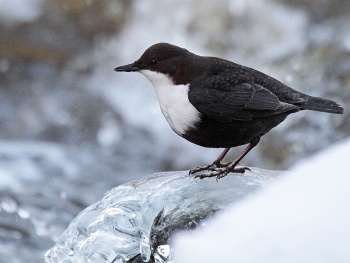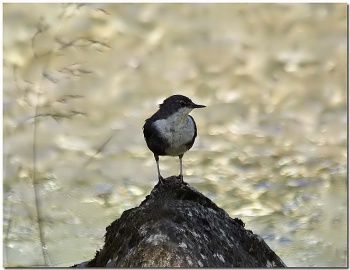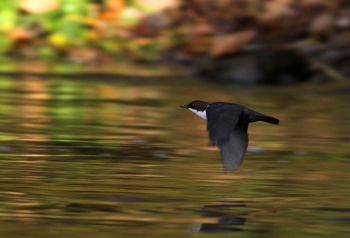m (→External Links: Video link amended) |
(changed 'Black-bellied Dipper' from alternative name to includes) |
||
| (20 intermediate revisions by 7 users not shown) | |||
| Line 1: | Line 1: | ||
| − | + | [[Image:White-throated_Dipper.jpg|thumb|550px|right|Photo © by {{user|Nigelblake|Nigel Blake}}<br />Dovedale, [[Derbyshire]], March 2004]] | |
| − | [[Image:White-throated_Dipper.jpg|thumb|550px|right|Photo by {{user| | + | |
;[[:Category:Cinclus|Cinclus]] cinclus | ;[[:Category:Cinclus|Cinclus]] cinclus | ||
| + | '''Includes: Black-bellied Dipper''' | ||
| + | |||
==Identification== | ==Identification== | ||
| − | 17-20 cm | + | [[Image:IMG 97731.jpg|thumb|350px|right|Nominate<br />Photo © by {{user|Macswede|Macswede}}<br />Nyfors, [[Sweden]], January 2013]] |
| + | (17-20 cm) 6.5-8 in | ||
*Dark above | *Dark above | ||
*White throat and bib | *White throat and bib | ||
| Line 10: | Line 13: | ||
*Black bill | *Black bill | ||
*Brownish legs | *Brownish legs | ||
| − | *Black eye has a [[Dictionary_M- | + | *Black eye has a [[Dictionary_M-O#N|nictating membrane]] |
| + | ====Variations==== | ||
| + | Differences in plumage between the subspecies is annotated in the Taxonomy section<sup>[[#Taxonomy|[1]]]</sup>. | ||
| − | |||
| − | |||
==Distribution== | ==Distribution== | ||
| − | Fairly common in suitable habitats in a widespread but discontinuous range. Breeds in [[Ireland]] and north and west [[Britain]], [[Spain]] and north [[Portugal]] and from southern and eastern [[France]] and [[Italy]] to the [[Balkans]] and [[Greece | + | [[Image:Dipper 75.jpg|thumb|350px|right|Juvenile, subspecies ''aquaticus''<br />Photo © by {{user|Donald+Talbott|Donald Talbott}}<br />Stara Fuzina Bohinj, [[Slovenia]], May 2012]] |
| + | Fairly common in suitable habitats in a widespread but discontinuous range. Breeds in [[Ireland]] and north and west [[Britain]], [[Spain]] and north [[Portugal]] and from southern and eastern [[France]] and [[Italy]] to the [[Balkans]] and [[Greece]]. | ||
| − | + | In the north found in central [[Denmark]] and throughout [[Norway]] and [[Sweden]], north [[Finland]] and the southern half of the Kola Peninsula. Isolated pockets in south Finland and the [[Baltic States]], in parts of north [[Russia]] and in the [[Urals]]. | |
| + | |||
| + | In the south breeds in the Caucasus and much of [[Turkey]], in the [[Lebanon]] and in [[Morocco]] and north [[Algeria]] and in the Mediterranean on [[Corsica]], possibly [[Sardinia]], and [[Sicily]], formerly also [[Cyprus]]. Has bred in the [[Netherlands]]. | ||
| − | Vagrants have been recorded on [[Svalbard]] and the [[Faroes]] and [[Malta]] and in [[Tunisia]] and [[Iraq]] (may breed). | + | Vagrants have been recorded on [[Svalbard]] and the [[Faroes]] and [[Malta]] and in [[Tunisia]] and [[Iraq]] (may breed). |
==Taxonomy== | ==Taxonomy== | ||
===Subspecies=== | ===Subspecies=== | ||
| − | + | [[Image:Dipper45.jpg|thumb|350px|right|Photo © by {{user|ivan+ellison|ivan ellison}}<br />River Irwell, Summerseat, [[Lancashire]], October 2009]] | |
| − | + | [[Image:20190503-134856 Fuji-X-T2 DSF8864.jpg|thumb|350px|right|Subspecies ''gularis'', Juvenile<br /> Photo © by {{user|Frank-birding |Frank-birding }}<br />[[Worcestershire]], [[UK]], 3 May 2019]] | |
| − | + | Thirteen subspecies are recognised by Clements<sup>[[#References|[1]]]</sup> | |
| − | + | * ''C. c. hibernicus'': | |
| − | + | :*[[Ireland]], Outer Hebrides and western coast of [[Scotland]]. Darker brown and chestnut of belly darker and less extensive. | |
| − | + | * ''C. c. gularis'': | |
| − | [[ | + | :*[[Orkney Islands]], central and eastern [[Scotland]], [[England]] and [[Wales]]. Strongly chestnut belly. |
| − | + | * ''C. c. cinclus'': | |
| − | ''C.c. | + | :*[[Scandinavia]] and northern [[Russia]] (to Kaliningrad region). Dark brown head and neck and blackish belly. |
| − | + | * ''C. c. aquaticus'': | |
| − | + | :*Central and southern Europe to Balkan Peninsula. Pale above, especially on head and neck, and brighter chestnut on the belly. | |
| − | + | * ''C. c. minor'': | |
| − | [[Caucasus | + | :*Mountains of Morocco, Tunisia and Algeria. Very similar to ''aquaticus'' but with fractionally longer bill. |
| − | + | * ''C. c. olympicus'': | |
| − | ''C.c.persicus'' | + | :* Formerly found on [[Cyprus]], extinct since the 1940s. |
| − | + | * ''C. c. caucasicus'': | |
| − | + | :*[[Caucasus]] Mountains to northwest [[Iran]], winters to [[Iraq]] and [[Pakistan]]. Dull and greyish above and dull brown below, barely tinged chestnut. | |
| − | *''C. c. leucogaster'': | + | * ''C. c. rufiventris'': |
| + | :*Anti-Lebanon Mountains, [[Lebanon]]. A pale race. | ||
| + | * ''C. c. persicus'': | ||
| + | :*Southwest [[Iran]] (Zagros and Bakhtiari mountains) , probably also in [[Azerbaijan]] and eastern [[Turkey]]. The largest and palest race. | ||
| + | * ''C. c. uralensis'': | ||
| + | :*Ural Mountains, [[Russia]]. Paler than nominate with belly tinged chestnut. | ||
| + | * ''C. c. leucogaster'': | ||
:*Mountains of central [[Asia]] | :*Mountains of central [[Asia]] | ||
| − | *''C. c. cashmeriensis'': | + | * ''C. c. cashmeriensis'': |
:*[[Himalayas]] (western Kashmir to Sikkim) | :*[[Himalayas]] (western Kashmir to Sikkim) | ||
| − | *''C. c. | + | * ''C. c. przewalskii'': |
:*Mountains of southern [[Tibet]] and western [[China]] | :*Mountains of southern [[Tibet]] and western [[China]] | ||
| + | |||
==Habitat== | ==Habitat== | ||
| − | Found along fast-flowing streams and rivers in upland areas, nesting in rocky banks or behind waterfalls, | + | Found along fast-flowing streams and rivers in upland areas, nesting in rocky banks or behind waterfalls, under bridges and in walls. In winter often moves to lower altitudes where seen at weirs, sometimes in slower moving parts of streams and on lake shores. |
==Behaviour== | ==Behaviour== | ||
| − | ==== | + | ====Action==== |
Fast direct flight low over the water. Walks and swims underwater. Perches on low rocks in a river, constantly bobbing. | Fast direct flight low over the water. Walks and swims underwater. Perches on low rocks in a river, constantly bobbing. | ||
====Diet==== | ====Diet==== | ||
| − | The diet | + | The diet consists of aquatic invertebrates, caddis worms, aquatic insect larvae, beetles, molluscs, and also small fish. |
====Breeding==== | ====Breeding==== | ||
| − | The domed nest is built from moss, straw and other vegetable matter, often placed on a ledge under a bridge, or any suitable crevice. The breeding season starts in March and three to six white eggs are laid. There may be a second brood. | + | The domed nest is built from moss, straw and other vegetable matter, often placed on a ledge under a bridge, or any suitable crevice. The breeding season starts in March and three to six white eggs are laid. |
| + | |||
| + | There may be a second brood or even third brood. | ||
| + | ====Movements==== | ||
| + | Most populations are basically resident but many make short-distance dispersal movements in autumn usually to lower altitudes. In the far north where waters become frozen makes longer movements and partially migratory leaving breeding areas in October-November and returning in March. | ||
====Vocalisation==== | ====Vocalisation==== | ||
| − | + | {{ Audio|Cinclus cinclus (song).mp3 }} | |
| − | + | ||
==References== | ==References== | ||
| − | #{{Ref- | + | #{{Ref-Clements6thAug18}}#Absolute Astronomy |
#Collins Bird Guide ISBN 0 00 219728 6 | #Collins Bird Guide ISBN 0 00 219728 6 | ||
| + | #Observer's Book of Birds' Eggs | ||
{{ref}} | {{ref}} | ||
==External Links== | ==External Links== | ||
| − | {{GSearch| | + | {{GSearch|"Cinclus cinclus" {{!}} "White-throated Dipper" {{!}} "Black-bellied Dipper"}} |
| + | <br /> | ||
| + | {{VSearch|"Cinclus cinclus" {{!}} "White-throated Dipper" {{!}} "Black-bellied Dipper"}} | ||
| + | {{GS-checked}}1 | ||
| + | <br /> | ||
<br /> | <br /> | ||
| − | |||
| − | [[Category:Birds]] [[Category:Cinclus]] [[Category:Bird Songs]] | + | [[Category:Birds]] [[Category:Cinclus]] [[Category:Bird Songs]] [[Category:Videos]] |
Latest revision as of 20:04, 14 February 2024
- Cinclus cinclus
Includes: Black-bellied Dipper
Identification
(17-20 cm) 6.5-8 in
- Dark above
- White throat and bib
- Chestnut band below bib
- Remainder of underparts are dark brown
- Black bill
- Brownish legs
- Black eye has a nictating membrane
Variations
Differences in plumage between the subspecies is annotated in the Taxonomy section[1].
Distribution
Fairly common in suitable habitats in a widespread but discontinuous range. Breeds in Ireland and north and west Britain, Spain and north Portugal and from southern and eastern France and Italy to the Balkans and Greece.
In the north found in central Denmark and throughout Norway and Sweden, north Finland and the southern half of the Kola Peninsula. Isolated pockets in south Finland and the Baltic States, in parts of north Russia and in the Urals.
In the south breeds in the Caucasus and much of Turkey, in the Lebanon and in Morocco and north Algeria and in the Mediterranean on Corsica, possibly Sardinia, and Sicily, formerly also Cyprus. Has bred in the Netherlands.
Vagrants have been recorded on Svalbard and the Faroes and Malta and in Tunisia and Iraq (may breed).
Taxonomy
Subspecies
Thirteen subspecies are recognised by Clements[1]
- C. c. hibernicus:
- C. c. gularis:
- Orkney Islands, central and eastern Scotland, England and Wales. Strongly chestnut belly.
- C. c. cinclus:
- Scandinavia and northern Russia (to Kaliningrad region). Dark brown head and neck and blackish belly.
- C. c. aquaticus:
- Central and southern Europe to Balkan Peninsula. Pale above, especially on head and neck, and brighter chestnut on the belly.
- C. c. minor:
- Mountains of Morocco, Tunisia and Algeria. Very similar to aquaticus but with fractionally longer bill.
- C. c. olympicus:
- Formerly found on Cyprus, extinct since the 1940s.
- C. c. caucasicus:
- C. c. rufiventris:
- Anti-Lebanon Mountains, Lebanon. A pale race.
- C. c. persicus:
- Southwest Iran (Zagros and Bakhtiari mountains) , probably also in Azerbaijan and eastern Turkey. The largest and palest race.
- C. c. uralensis:
- Ural Mountains, Russia. Paler than nominate with belly tinged chestnut.
- C. c. leucogaster:
- Mountains of central Asia
- C. c. cashmeriensis:
- Himalayas (western Kashmir to Sikkim)
- C. c. przewalskii:
Habitat
Found along fast-flowing streams and rivers in upland areas, nesting in rocky banks or behind waterfalls, under bridges and in walls. In winter often moves to lower altitudes where seen at weirs, sometimes in slower moving parts of streams and on lake shores.
Behaviour
Action
Fast direct flight low over the water. Walks and swims underwater. Perches on low rocks in a river, constantly bobbing.
Diet
The diet consists of aquatic invertebrates, caddis worms, aquatic insect larvae, beetles, molluscs, and also small fish.
Breeding
The domed nest is built from moss, straw and other vegetable matter, often placed on a ledge under a bridge, or any suitable crevice. The breeding season starts in March and three to six white eggs are laid.
There may be a second brood or even third brood.
Movements
Most populations are basically resident but many make short-distance dispersal movements in autumn usually to lower altitudes. In the far north where waters become frozen makes longer movements and partially migratory leaving breeding areas in October-November and returning in March.
Vocalisation
References
- Clements, J. F., T. S. Schulenberg, M. J. Iliff, D. Roberson, T. A. Fredericks, B. L. Sullivan, and C. L. Wood. 2018. The eBird/Clements checklist of birds of the world: v2018. Downloaded from http://www.birds.cornell.edu/clementschecklist/download/
- Absolute Astronomy
- Collins Bird Guide ISBN 0 00 219728 6
- Observer's Book of Birds' Eggs
Recommended Citation
- BirdForum Opus contributors. (2024) White-throated Dipper. In: BirdForum, the forum for wild birds and birding. Retrieved 8 September 2024 from https://www.birdforum.net/opus/White-throated_Dipper
External Links
GSearch checked for 2020 platform.1








